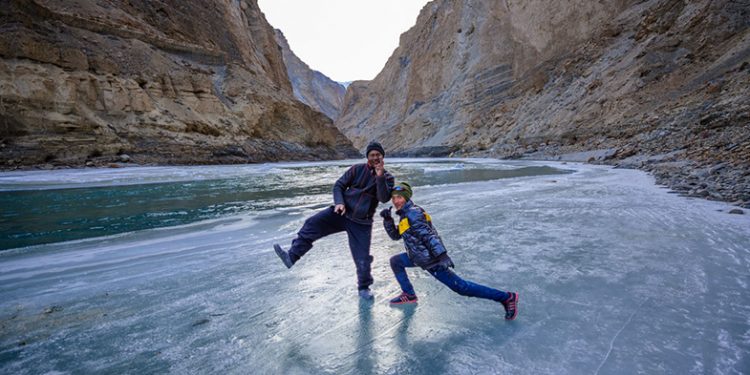Introduction
The Himalayas, which stretch across India, Bhutan, and Nepal, with their beginning and end in Pakistan and China, are home to the world’s highest peaks. While Everest gets the most attention, several other peaks are striking and unique in their characteristics, existing nowhere else in the world and cannot be replicated, especially when you consider the mountain ranges west of the Indus – the Pamir, Hindu Kush, and the Karakoram.
We are privileged to have been born in a country with such a spectacular landscape. We’ve all wanted to trek the Himalayas at some point in our lives. Some of us have made that dream a reality, while others are still thinking about it. Whatever the case may be, there is always more to learn and more peaks to conquer; the Himalayan list is far from complete. Trekking in the Himalayas of India
1. Chadar Hike
Chadar’s experience can be summed up in one word: surreal, but the Chadar trek has its unique elements. In terms of route history, the formation of thick ice on the Zanskar river during the winter months allows the locals to use it as a bridge to connect toOn the other hand, gather supplies for the coming months on the other side. According to legend, trekking through Chadar was so dangerous and unpredictable back then that every person who attempted it died.
Villagers would make sure to pay off their debts and dues before embarking on the journey, just in case the river swallowed them.
3383 metres above sea level
Difficulty: Moderate
2. Glacier Beas Kund
The Beas Kund is the source of the mighty river Beas. The river originates from the glaciers and flows through scenic meadows surrounded by mountains.
Across one side, the Pir Panjal Mountain Ranges, while on the other, the Dhauladhar Mountain Ranges. The flora and fauna of the Beas Kund trek are abundant. Shepherds camp around Beas Kund with herds of sheep and watchdogs, making it a popular destination for them.
You get a sense of the environment’s purity when you’re in it.
the glory of virginity As the glaciers melt, the water there is the purest.
3700 metres above sea level
Easy to Moderate Difficulty
The great season to visit is between May and October.
3. Har Ki Dun (Harki Dun)
Har Ki Dun is a delight for trekkers who have visited the Himalayas in both summer and winter. There are many different trees, animals, plants, and other things to see on the trek from Sankri to Osla. On the way, you’ll pass through the Govind Wildlife Sanctuary, where you can see a variety of animals such as parakeets and vultures. Every night, you’ll be able to see billions of stars.
Difficulty: Easy to Moderate Altitude: 6,200m
The busiest times to visit are April to June.
4. Deoriatal Chandrashila
Don’t miss this opportunity if you’re planning a Himalayan trek. It’s one of the most beautiful experiences, even though it’s easier. On the way to Chandrashila Peak, there are flocks of peacocks and herds of deer to be seen. Chandrashila is known for its breathtaking sunrises. The entire sky clears up as the sun slowly rises, illuminating your face with the golden rays of the red sun. With a full moon, the lower hills beside the peak clear up. The Nanda Devi and Kedar Peaks can be seen in the distance, as well as abandoned houses. It’s nothing short of a miracle.
4,000 metres above sea level
Difficulty: Simple
The seasons of April to June are perfect for a visit.
5. Hampta Pass is a mountain pass in the United States.
Hampta Pass is a complete package, with high and dark pine forests, glacier valleys, river-side camping, and much more. The route includes more than 40 sharp bends and offers a beautiful view of Manali and the Kullu Valley. Following that, there are short walks through pine forests. The air is filled with the sight and sound of rivers that run vertically alongside the rocks, giving the mountains the appearance of being carved with a mountain knife.
4,270 metres above sea level
Easy to Moderate Difficulty
When is the best time to visit: Mid-June to Mid-October is the best time to visit.
5. Trekking in Chopta Chandrashila
Chandrashila, which translates to “moon rock,” is a peak on the Tungnath that rises to about 4,000 metres above sea level. This trek is well-known because it can be visited at any time of year, and each season offers a unique level of fun, thrill, and excitement. This trial will fuel your inner adventure as you fall in love with the crystal white snow that blankets the mountains, the birds that make beautiful music, and the forests that will bring you closer to your inner self. The most exciting aspect of this trek is that it allows you to see other peaks, such as Nandadevi, Trisul, Kedar Peak, Bandarpunch, and Chaukhamba, in addition to the Himalayas.
12,100 feet above sea level
Moderate difficulty
This trek will take between 3 and 6 days to complete.
The best days to take a trip are April to June.


